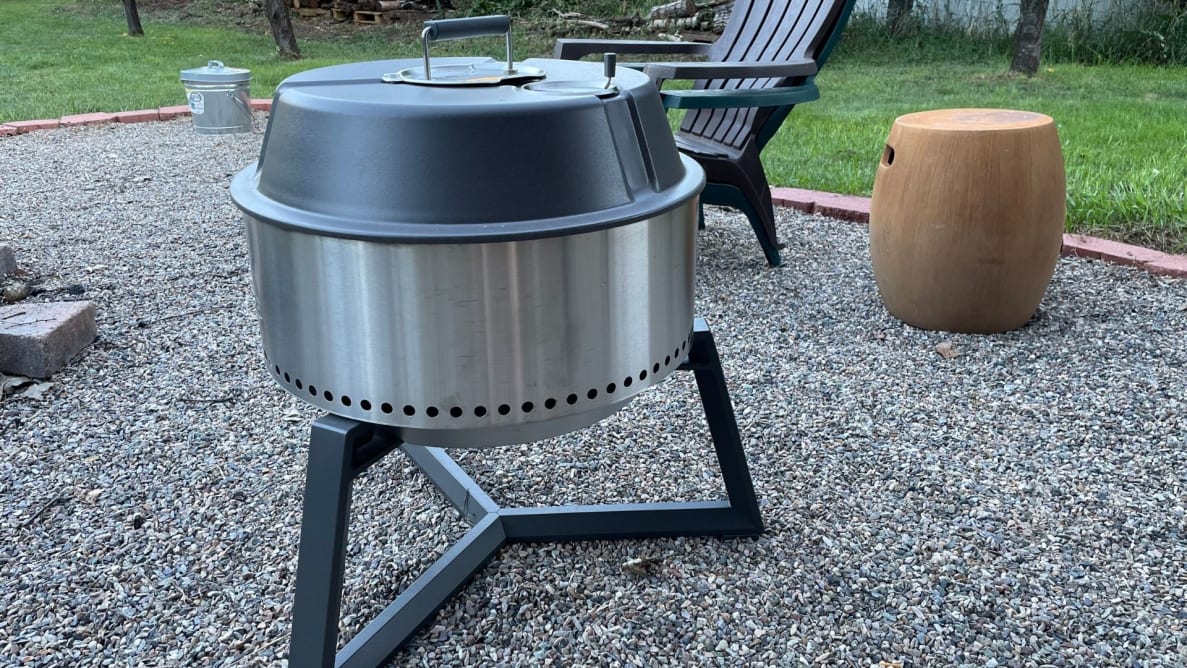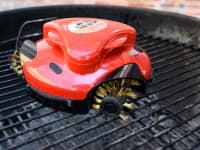Pros
-
Bigger than most portable charcoal grills
-
Cooks effectively with direct and indirect heat
-
Bundle includes everything you need
Cons
-
No handles on grill
-
No adjustable vents
-
The stand is relatively short
Review body
Most charcoal grills are built with the same principle in mind: Load them up with lump charcoal or briquettes and use the vents on the top and bottom of the grill to control the heat. When you open the bottom vents, oxygen rushes into the grill, fueling the coals and creating intense heat. Close ‘em up, and you’ll choke off that oxygen to lower the temps.
The Solo Stove Grill is different because it rejects this long-accepted method. While the lid does have an adjustable vent, allowing you to release hot air from the grill or keep the smoke inside the dome, it doesn’t have any adjustable vents on the bottom. Instead, Solo Stove uses what it calls 360° Airflow technology to create a convection cooking environment. That lets air flow in specific patterns throughout the grill, using less charcoal than a traditional grill, and the grill should heat up faster as well.
The upside of this design is that it’s set it and forget it. Say goodbye to fiddling with vents, and you’ll never have to worry about whether you got the settings right. The grill will always create ideal searing conditions, so all you have to concentrate on is flipping your burgers and pulling them when they’re finished. The downside? You can only use the grill at one temperature—somewhere between 400°F to 500°F. You can adjust the coals to create a two-zone fire for indirect heating if you want to cook longer-cooking items like brats or chicken drumsticks, but it’s not possible to lower the grill temperature for low-and-slow grilling sessions.
The other bonus of the Solo Stove Grill is it can be used with multiple fuel sources. Most grills are designed to work with lump charcoal or briquettes only. Both types of charcoal work well on the Solo Stove Grill, but you can also use wood or wood chunks if you prefer.
About the Solo Stove Ultimate Grill Bundle
Dimensions: 29.4" x 22" x 22" (H x W x D) Weight: 38 lbs. 8 oz. Finishes: Stainless steel Features: Solo Stove Grill, 13-inch portable grill stand, spatula, tongs, meat fork, grill shelter, grill carry case, all-natural charcoal briquettes (4 pounds), and a 4-pack of starters Fuel Type: Charcoal
How we tested
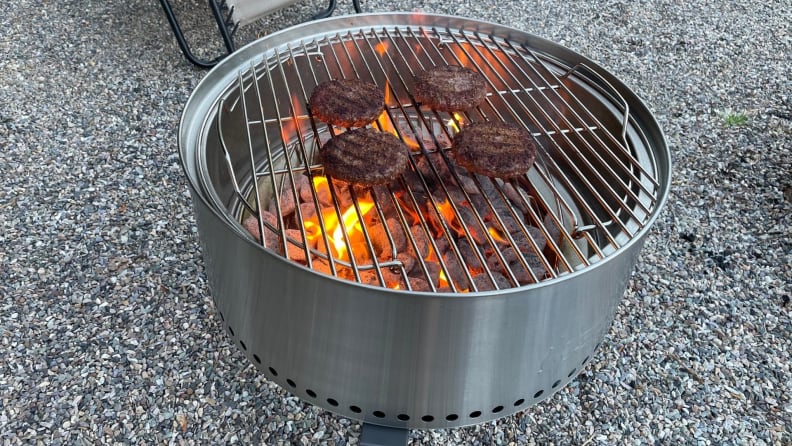
We looked at the char pattern on each burger to see how the grill grate impacted the burger's appearance.
We tested the Solo Stove Grill Ultimate Bundle using the same method we developed when testing portable gas and charcoal grills—this list is currently being retested and will be updated this fall. After assembling the grill, we assessed the size of the Solo Stove’s cooking surface, as well as its weight, charcoal efficiency, ease of transport, and overall performance.
We started by building a tower of charcoal in the grill and timing how long it took to ignite the coals. Normally, we’d load about 100 briquettes into a chimney starter to create a 500°F direct-sear grilling environment, but Solo Stove recommends using fewer briquettes than a regular grill—four pounds, or 60 briquettes—and says you can start the charcoal directly inside the unit instead of using a starter. So, we built a pyramid using four pounds of charcoal, buried a starter cuber in the middle, and lit it on fire. We timed how long it took until the coals were ready for cooking (when the ones in the middle to glow bright red and the ones on top to become white and ashy).
Since most people use a grill to sear foods like burgers and steaks, we started our testing at the highest possible temperature. After the coals were ready, we distributed them across the entire grilling area and covered the grill with the lid to let the temperature build. The Solo Stove doesn’t have a thermometer in the lid, so we used the tried-and-true hand test to check temperature: Place your hand about 5 inches above the coal bed. If you need to pull it away after 2 to 4 seconds, it’s hot enough to sear steaks or cook burgers. We grilled burgers on the uncovered grill, spaced 2 inches apart, cooking them for 5 minutes on each side. When the timer expired, we measured the internal temperature of each burger in hopes that they were all within 5 to 10 degrees of each other. We also assessed the char pattern and grill marks of each burger to see how the grill grate’s material contributed to the test.
Next up, we lit the charcoal using the same method as above. This time, we arranged the coals into an indirect heat pattern when they were ready, moving all the briquettes to one side of the grill. This two-zone cooking style is perfect for grilling items that take longer than 30 minutes to finish—like chicken, thick steaks, or a rack of ribs—cooking them through without burning the exterior. Chicken drumsticks were the perfect option for this test, and we were looking for cooked-through chicken with perfectly even, golden brown skin in about 30 minutes.
We finished our assessment by looking at the grill’s aesthetics and build quality. Did the grill feel sturdy, and was it easy to move? Does it have side tables, and could they hold heavy food items? Was there a place to hang the lid while you’re cooking on an open grill, and do the handles get too hot to touch? Was the ash pan accessible (and, more importantly, easy to clean out)? After compiling the scores, some of these design choices made a huge difference in the grill’s overall ranking.
What we like about the Solo Stove Grill
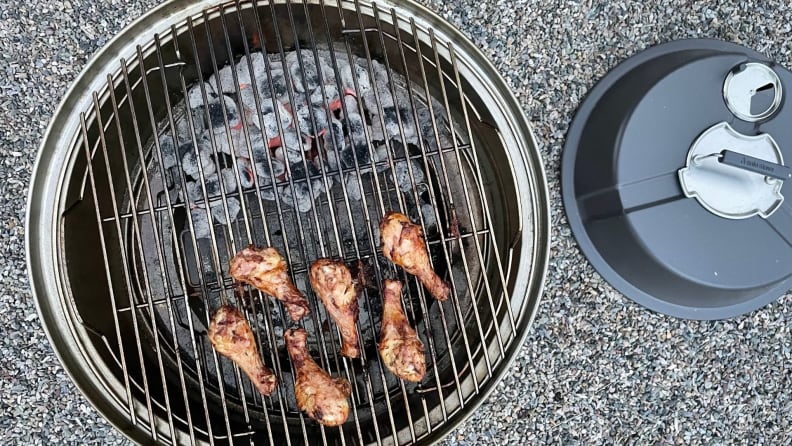
This portable charcoal grill has plenty of surface area for grilling food to feed a crowd.
It’s bigger than most portable grills
The Solo Stove Grill definitely fits in the portable grill category. It comes with a carrying case, and it’s easy to remove the grill from the stand and transport it to your favorite beach or tailgating setting. That said, this grill is much larger than most portable grills we’ve tested. Its 22-inch grate is the same size as a Weber Original Kettle Grill, so you could easily make the Solo Stove your backyard staple in addition to your on-the-go grill.
The grill only requires four pounds of charcoal to create ideal cooking conditions, but it’s large enough to fit an entire chimney of charcoal. The 22-inch grill grate creates 360 square inches of cooking space, or enough to fit about 12 burgers. With the lid, this grill is not quite large enough to fit a whole turkey (unless you spatchcock it), but it does fit several whole chickens.
It works well with direct and indirect heat
We tested the Solo Stove Grill two ways: using direct heat, with the coals spread out over the entire grill, and with indirect heat, where we created a two-zone fire by piling the coals on one side of the grill. Both methods worked well, creating burgers with well-etched grill marks and chicken that crisped up but cooked through without burning the exterior. Regardless of the cooking method, the lid handle stayed cool, a feature we definitely appreciated.
The fire lasts long enough for a full grilling session
We were worried that the coals would burn out too quickly given the lack of vents and convection air flow, but our worries were in vain. Solo Stove says four pounds of charcoal will create a fire that can last 45 minutes. In our tests, we found the coal bed lasted a little longer than that. Our indirect-heat chicken was finished right at 30 minutes, and the grill continued to produce heat hot enough to cook over for another 30 minutes, easily. It was still hot enough to toast buns well after an hour.
The Ultimate Bundle package comes with everything you need
The price may be a little high on this grill compared to other portable grills we tested, but we love that the bundle comes with everything you need. In addition to the grill and stand, you’ll receive a cover to keep the grill protected from the elements, a set of grilling tools (spatula, tongs, and meat fork), and a carrying case. The bundle also comes with a four-pound bag of charcoal and some fire starters. If it came with steak and brats, you wouldn’t even need to hit the grocery store the day the grill arrived!
It’s easy to set up and break down
Some grills take over an hour to build, but the Solo Stove Grill was ready to use less than five minutes after unboxing. Simply put the stand together by screwing in six bolts and place the grill on top of the stand. To break the grill down, pull the grill off the stand (but make sure it’s cool enough to handle, first!). Place it in the carrying case, and on you go. That makes it the perfect option for an on-the-go grilling session on the beach or while tailgating.
Cleaning is a breeze
Some charcoal grills have complicated sliding door systems to remove the ashes, but the Solo Stove keeps it simple. The charcoal sits on a grate above a removable ash pan. When the coals are extinguished and cool to the touch, grab the charcoal grate by the handles (a nice feature that keeps your hands from getting too dirty). That gives you access to the ash pan, which you can pull it out, dump into the trash can, and put it all back together. Easy, peasy.
What we don’t like about the Solo Stove Grill
The grill doesn’t have handles
The Solo Stove Grill doesn’t have handles on the sides, which makes it extremely hard to move around. The grill sits on a stand, and removing the grill from the base is as easy as separating the two pieces. But the grill isn’t exactly light (it’s almost 39 pounds!), and without handles, it’s a little awkward to move. The lack of handles also means it can’t be moved while the grill is in use or while the coals are still hot because the sides heat up.
There are no adjustable vents
We appreciate that the Solo Stove Grill is trying to something different with their convective heating environment, and we were more than happy with the food we cooked on it. It all turned out perfectly cooked, and the burgers and chicken tasted just as good as anything we cooked on other charcoal grills. The lack of vents does make the grill easy to use, but it also means you can’t customize the cooking session. It can only cook at 400°F to 500°F, so you can’t use the grill as a smoker to cook low-and-slow items. That may not be a big deal for some, but it could be a deal breaker for others.
The stand is a little short
The Ultimate Bundle comes with Solo Stove’s short stand, which is only 13 inches tall. When used with the grill, that creates a 21-inch cooking height. For most of us, that means we’re hunching down to grill. Solo Stove does sell a tall stand that’s 21.5 inches, bringing the cooking surface to a slightly better 28 inches. Considering that standard countertops are 36 inches tall, both fall a little short.
We would forgive this if the grill was designed to sit on top of a picnic table, like many portable grills. Unfortunately, the Solo Stove Grill isn’t meant to be used on any surface other than the stand, as it’s not perfectly level on the bottom and the bottom gets very hot.
There are no side tables
This isn’t a huge one—only a few portable grills we tested have built-in side tables—but we wish the Solo Stove Grill had some kind of side table or workstation. It would definitely interfere with the sleek, round look, but it would be a nice feature (especially for the price).
Warranty
Solo Stove boasts 100% guaranteed returns and a lifetime warranty that guarantees your Solo Stove Grill to be free of any manufacturing defects. That warranty doesn’t protect against accidental damage like breaks or drops, but they offer two-, three-, and five-year extended warranties through Extend.
Should you buy the Solo Stove Grill Ultimate Bundle?
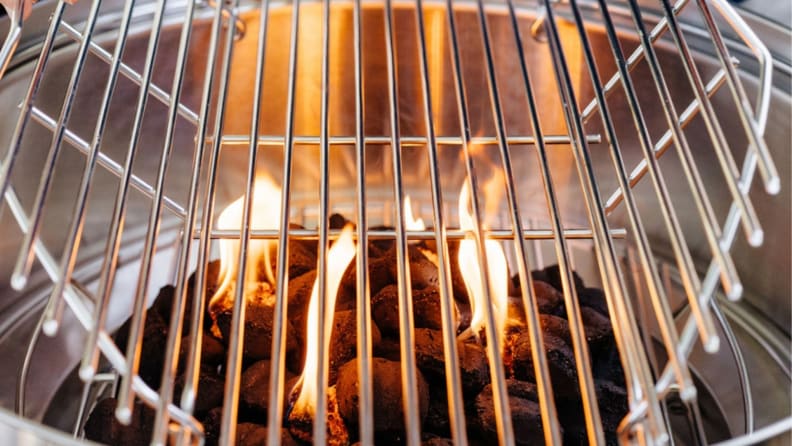
The Solo Stove Ultimate Grill Bundle performed almost as well as our best overall portable charcoal grill.
Yes, but know that its grilling functions are somewhat limited
Overall, we were extremely happy with the Solo Stove Grill’s performance on both direct and indirect heat cooking. It was easy to use and store, quick to ignite, and created delicious-tasting food. That said, the price tag isn’t exactly palatable for a charcoal grill, especially one that only works at one temperature. Even at the current sale price, the Solo Stove is over four times more expensive than our winning portable charcoal grill, and it’s almost twice the price of our winning charcoal grill.
So it really comes down to how you want to cook. Do you want to be able to smoke meat or control the temperature for low-and-slow cooking? This isn’t the grill for you—consider a pellet grill instead. Do you want a fully functional grill that can cook incredible-tasting burgers, brats, hot dogs, kebabs, and more? And do you want that grill to be portable and look good doing it? Then this grill is absolutely a great fit, especially if budget isn’t an object.
You’re on your way to becoming a kitchen master. Take the next step and sign up for Chef's Course. You’ll get weekly tips, tricks, and recipes from top chefs sent straight to your inbox. It’s a whole master course for free.
Meet the tester
Lindsay is a professional chef, recipe developer, writer, and developmental editor. After years of working in restaurant kitchens, she turned to writing to share her passion for local, organic, and seasonal ingredients with home cooks and food enthusiasts.
Checking our work.
Our team is here to help you buy the best stuff and love what you own. Our writers, editors, and experts obsess over the products we cover to make sure you're confident and satisfied. Have a different opinion about something we recommend? Email us and we'll compare notes.
Shoot us an email